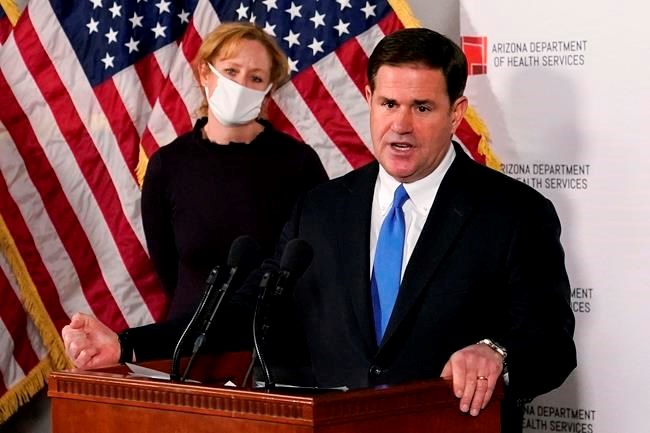PHOENIX — As Arizona experienced periodic spikes in COVID-19 cases since last spring, Gov. Doug Ducey frequently resisted calls to take strong measures. He has declined to institute a statewide mask mandate, allowed school districts to mostly make their own choices and allowed businesses to stay open.
All of those choices by the Republican governor are now getting renewed scrutiny as the Grand Canyon state becomes what health officials call the latest “hot spot of the world” because of soaring case loads.
“We have a governor and health director who don’t care. Their goal in my opinion is to vaccinate their way out of this,” said Will Humble, head of the Arizona Public Health Association “Eventually it will work. There’s just going to be a lot of dead people in the meantime.”
C.J. Karamargin, the governor’s spokesman, said the current number of cases and deaths are “heartbreaking” but it’s a phenomenon happening in other states even with strict stay-at-home orders.
“Faced with strict mitigation measures in place and states that have few or minimal mitigation measures in place all are experiencing the same thing,” Karamargin said. “The mitigation measures the state of Arizona put into place early on — they remain in place. We urge every Arizonan to follow them.”
At the same time, the state is working to ramp up vaccination distribution efforts, Karamargin added. More than 119,000 people in Arizona have received the vaccine, state health officials said Wednesday. That is is less than 2% of the state's population. Nationally, as of Wednesday, more than three weeks into the U.S. vaccination campaign, 5.3 million people had gotten their first dose.
Liz Curren, 34, of Phoenix, has been watching over her husband, Russell, 37, since he became infected with the virus more than a week ago. His symptoms have included severe body aches, chills and pain in his lungs and kidneys. The couple and four other relatives gathered at Christmas but took every precaution like wearing masks. Yet, Russell Curren and three others ended up later testing positive. Liz Curren has tested negative three times.
“I absolutely think there’s more or there should be more done,” Liz Curren said, reflecting on the jump in cases. “Whatever's being done is not working. I don’t feel like clubs and bars and gyms should be open.”
Meanwhile, the death toll in Arizona from the pandemic is now nearing 10,000. State health officials on Thursday reported 297 new virus-related deaths. Most of them were attributed to recent reviews of past death certificates.
The state also tallied 9,913 newly confirmed COVID-19 cases on Thursday, bringing the overall total so far to 584,593.
Arizona has the worst coronavirus diagnosis rate in the country, with 1 out of every 119 people in the state testing positive in the past week, health officials said.
Just five months ago, President Donald Trump hailed Arizona as a model for how it dealt with the COVID-19 pandemic. After a stay-at-home order early in the pandemic was gradually lifted, the Republican governor declined to reimpose restrictions like
Ducey has rejected calls from health care leaders to tighten restrictions, arguing it would cause people to be out of work. He also dismissed a proposal to have all public schools go to virtual learning for two weeks after the holidays.
The live-and-let-live approach arguably worked for some months, as cases remained high but more arguably manageable compared to the situation in the summer. In recent days, the numbers have skyrocketed.
“It’s way worse than July already, and it’s going to continue to get worse. We’re probably two weeks behind LA in terms of our situation,” said Humble, referring to Los Angeles County, where a COVID-19 surge has created a shortage of oxygen and led ambulance crews to stop transporting patients they can’t revive in the field.
Dr. Joshua LaBaer, director of the Biodesign Institute research
“That means if you’re at the supermarket, there are people around you who have it but they may not know it yet,” LaBaer said. “It’s not a time where I would recommend people spend time indoors with people who are not their immediate family.”
The state also “without a doubt” will see more deaths than usual for the winter months, LaBaer said. Aside from COVID-19-related deaths, people with other illnesses who hesitate to go to the hospital are at risk.
A record 4,920 COVID-19 patients were occupying hospital beds as of Wednesday, according to the state coronavirus dashboard.
Dr. Marjorie Bessel, chief clinical officer of Banner Health, the state’s largest hospital chain, said the uncontrollable spread of the virus could be lessened if the government enforced mask requirements, barred indoor dining and
“We are not doing a good job with this virus,” Bessel said of the state. “At this time during the surge of the pandemic, we need additional mitigation. We need enforcement of those mitigation activities, and we need everybody to do their own part.”
Dr. Michael White, chief clinical officer of Arizona’s Valleywise Health said the Phoenix-based health care system has no intensive care beds available. Some patients waiting for beds were being treated on gurneys in the emergency department.
“I’ve never seen anything like this in all the years I’ve been part of health care,” White said.
More mitigation efforts in early December would have likely helped with the surge hospitals are seeing now, he added.
Virus case numbers have been trending upward since Arizona bars, nightclubs and restaurants were allowed to fully reopen in September. But travel and people gathering for the holidays, starting with Thanksgiving, was “gasoline that went onto the fire,” said Humble.
___
Associated Press writers Jacques Billeaud and Paul Davenport contributed to this report.
Terry Tang, The Associated Press

